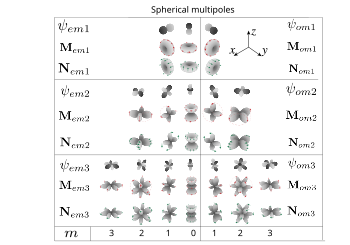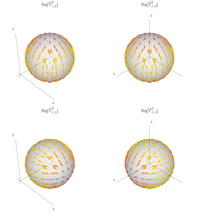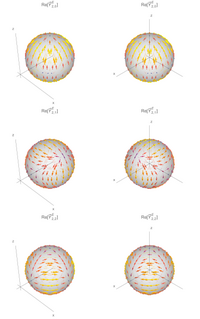Vector spherical harmonics
In mathematics, vector spherical harmonics (VSH) are an extension of the scalar spherical harmonics for use with vector fields. The components of the VSH are complex-valued functions expressed in the spherical coordinate basis vectors.
Definition
Several conventions have been used to define the VSH.[1][2][3][4][5] We follow that of Barrera et al.. Given a scalar spherical harmonic Yℓm(θ, φ), we define three VSH:
with being the unit vector along the radial direction in spherical coordinates and the vector along the radial direction with the same norm as the radius, i.e., . The radial factors are included to guarantee that the dimensions of the VSH are the same as those of the ordinary spherical harmonics and that the VSH do not depend on the radial spherical coordinate.
The interest of these new vector fields is to separate the radial dependence from the angular one when using spherical coordinates, so that a vector field admits a multipole expansion
The labels on the components reflect that is the radial component of the vector field, while and are transverse components (with respect to the radius vector ).
Main properties
Symmetry
Like the scalar spherical harmonics, the VSH satisfy
which cuts the number of independent functions roughly in half. The star indicates complex conjugation.
Orthogonality
The VSH are orthogonal in the usual three-dimensional way at each point :
They are also orthogonal in Hilbert space:
An additional result at a single point (not reported in Barrera et al, 1985) is, for all ,
Vector multipole moments
The orthogonality relations allow one to compute the spherical multipole moments of a vector field as
The gradient of a scalar field
Given the multipole expansion of a scalar field
we can express its gradient in terms of the VSH as
Divergence
For any multipole field we have
By superposition we obtain the divergence of any vector field:
We see that the component on Φℓm is always solenoidal.
Curl
For any multipole field we have
By superposition we obtain the curl of any vector field:
Laplacian
The action of the Laplace operator separates as follows:
where and
Also note that this action becomes symmetric, i.e. the off-diagonal coefficients are equal to , for properly normalized VSH.
Examples
First vector spherical harmonics
- .
- .
- .
Expressions for negative values of m are obtained by applying the symmetry relations.
Applications
Electrodynamics
The VSH are especially useful in the study of multipole radiation fields. For instance, a magnetic multipole is due to an oscillating current with angular frequency and complex amplitude
and the corresponding electric and magnetic fields, can be written as
Substituting into Maxwell equations, Gauss's law is automatically satisfied
while Faraday's law decouples as
Gauss' law for the magnetic field implies
and Ampère–Maxwell's equation gives
In this way, the partial differential equations have been transformed into a set of ordinary differential equations.
Alternative definition

In many applications, vector spherical harmonics are defined as fundamental set of the solutions of vector Helmholtz equation in spherical coordinates.[6][7]
In this case, vector spherical harmonics are generated by scalar functions, which are solutions of scalar Helmholtz equation with the wavevector . here are the associated Legendre polynomials, and are any of the spherical Bessel functions.
Vector spherical harmonics are defined as:
- longitudinal harmonics
- magnetic harmonics
- electric harmonics
Here we use harmonics real-valued angular part, where , but complex functions can be introduced in the same way.
Let us introduce the notation . In the component form vector spherical harmonics are written as:
There is no radial part for magnetic harmonics. For electric harmonics, the radial part decreases faster than angular, and for big can be neglected. We can also see that for electric and magnetic harmonics angular parts are the same up to permutation of the polar and azimuthal unit vectors, so for big electric and magnetic harmonics vectors are equal in value and perpendicular to each other.
Longitudinal harmonics:
Orthogonality
The solutions of the Helmholtz vector equation obey the following orthogonality relations:[7]
All other integrals over the angles between different functions or functions with different indices are equal to zero.
Rotation and inversion

Under rotation, vector spherical harmonics are transformed through each other in the same way as the corresponding scalar spherical functions, which are generating for a specific type of vector harmonics. For example, if the generating functions are the usual spherical harmonics, then the vector harmonics will also be transformed through the Wigner D-matrices[8][9][10] The behavior under rotations is the same for electrical, magnetic and longitudinal harmonics.
Under inversion, electric and longitudinal spherical harmonics behave in the same way as scalar spherical functions, i.e. and magnetic ones have the opposite parity:
Fluid dynamics
In the calculation of the Stokes' law for the drag that a viscous fluid exerts on a small spherical particle, the velocity distribution obeys Navier–Stokes equations neglecting inertia, i.e.,
with the boundary conditions
where U is the relative velocity of the particle to the fluid far from the particle. In spherical coordinates this velocity at infinity can be written as
The last expression suggests an expansion in spherical harmonics for the liquid velocity and the pressure
Substitution in the Navier–Stokes equations produces a set of ordinary differential equations for the coefficients.
Integral relations
Here the following definitions are used:
In case, when instead of are spherical Bessel functions, with help of plane wave expansion one can obtain the following integral relations:[11]
In case, when are spherical Hankel functions, one should use the different formulae.[12][11] For vector spherical harmonics the following relations are obtained:
where , index means, that spherical Hankel functions are used.
See also
- Spherical harmonics
- Spinor spherical harmonics
- Spin-weighted spherical harmonics
- Electromagnetic radiation
- Spherical basis
References
- ^ Barrera, R G; Estevez, G A; Giraldo, J (1985-10-01). "Vector spherical harmonics and their application to magnetostatics". European Journal of Physics. 6 (4). IOP Publishing: 287–294. Bibcode:1985EJPh....6..287B. CiteSeerX 10.1.1.718.2001. doi:10.1088/0143-0807/6/4/014. ISSN 0143-0807. S2CID 250894245.
- ^ Carrascal, B; Estevez, G A; Lee, Peilian; Lorenzo, V (1991-07-01). "Vector spherical harmonics and their application to classical electrodynamics". European Journal of Physics. 12 (4). IOP Publishing: 184–191. Bibcode:1991EJPh...12..184C. doi:10.1088/0143-0807/12/4/007. ISSN 0143-0807. S2CID 250886412.
- ^ Hill, E. L. (1954). "The Theory of Vector Spherical Harmonics" (PDF). American Journal of Physics. 22 (4). American Association of Physics Teachers (AAPT): 211–214. Bibcode:1954AmJPh..22..211H. doi:10.1119/1.1933682. ISSN 0002-9505. S2CID 124182424. Archived from the original (PDF) on 2020-04-12.
- ^ Weinberg, Erick J. (1994-01-15). "Monopole vector spherical harmonics". Physical Review D. 49 (2). American Physical Society (APS): 1086–1092. arXiv:hep-th/9308054. Bibcode:1994PhRvD..49.1086W. doi:10.1103/physrevd.49.1086. ISSN 0556-2821. PMID 10017069. S2CID 6429605.
- ^ P.M. Morse and H. Feshbach, Methods of Theoretical Physics, Part II, New York: McGraw-Hill, 1898-1901 (1953)
- ^ Bohren, Craig F. and Donald R. Huffman, Absorption and scattering of light by small particles, New York : Wiley, 1998, 530 p., ISBN 0-471-29340-7, ISBN 978-0-471-29340-8 (second edition)
- ^ a b Stratton, J. A. (1941). Electromagnetic Theory. New York: McGraw-Hill.
- ^ D. A. Varhalovich, A. N. Moskalev, and V. K. Khersonskii, Quantum Theory of Angular Momentum [in Russian], Nauka, Leningrad (1975)
- ^ Zhang, Huayong; Han, Yiping (2008). "Addition theorem for the spherical vector wave functions and its application to the beam shape coefficients". J. Opt. Soc. Am. B. 25 (2): 255–260. Bibcode:2008JOSAB..25..255Z. doi:10.1364/JOSAB.25.000255.
- ^ Stein, Seymour (1961). "Addition theorems for spherical wave functions". Quarterly of Applied Mathematics. 19 (1): 15–24. doi:10.1090/qam/120407.
- ^ a b Stout, B. (2012). Popov, E (ed.). "Spherical harmonic lattice sums for gratings" (PDF). Institut Fresnel, Universite d'Aix-Marseille 6. Gratings: theory and numeric applications.
- ^ Wittmann, R. C. (1988). "Spherical wave operators and the translation formulas". IEEE Transactions on Antennas and Propagation. 36 (8): 1078–1087. Bibcode:1988ITAP...36.1078W. doi:10.1109/8.7220.





































































![{\displaystyle {\begin{aligned}{\mathbf {N} _{emn}(k,\mathbf {r} )=\qquad {\frac {z_{n}(\rho )}{\rho }}\cos(m\varphi )n(n+1)P_{n}^{m}(\cos(\theta ))\mathbf {e} _{\mathbf {r} }}\\{{}+\cos(m\varphi ){\frac {dP_{n}^{m}(\cos(\theta ))}{d\theta }}}{\frac {1}{\rho }}{\frac {d}{d\rho }}\left[\rho z_{n}(\rho )\right]\mathbf {e} _{\theta }\\{{}-m\sin(m\varphi ){\frac {P_{n}^{m}(\cos(\theta ))}{\sin(\theta )}}}{\frac {1}{\rho }}{\frac {d}{d\rho }}\left[\rho z_{n}(\rho )\right]\mathbf {e} _{\varphi }\end{aligned}}}](https://wikimedia.org/api/rest_v1/media/math/render/svg/8331b5c5a9b7381413a4230f6dd294ea6e29ddca)
![{\displaystyle {\begin{aligned}\mathbf {N} _{omn}(k,\mathbf {r} )=\qquad {\frac {z_{n}(\rho )}{\rho }}\sin(m\varphi )n(n+1)P_{n}^{m}(\cos(\theta ))\mathbf {e} _{\mathbf {r} }\\{}+\sin(m\varphi ){\frac {dP_{n}^{m}(\cos(\theta ))}{d\theta }}{\frac {1}{\rho }}{\frac {d}{d\rho }}\left[\rho z_{n}(\rho )\right]\mathbf {e} _{\theta }\\{}+{m\cos(m\varphi ){\frac {P_{n}^{m}(\cos(\theta ))}{\sin(\theta )}}}{\frac {1}{\rho }}{\frac {d}{d\rho }}\left[\rho z_{n}(\rho )\right]\mathbf {e} _{\varphi }\end{aligned}}}](https://wikimedia.org/api/rest_v1/media/math/render/svg/2d56063fb7f9fabaf20e04730bd1eeaf79296847)


![{\displaystyle {\begin{aligned}\int _{0}^{2\pi }\int _{0}^{\pi }\mathbf {L} _{^{e}_{o}mn}\cdot \mathbf {L} _{^{e}_{o}mn}\sin \vartheta d\vartheta d\varphi &=(1+\delta _{m,0}){\frac {2\pi }{(2n+1)^{2}}}{\frac {(n+m)!}{(n-m)!}}k^{2}\left\{n\left[z_{n-1}(kr)\right]^{2}+(n+1)\left[z_{n+1}(kr)\right]^{2}\right\}\\[3pt]\int _{0}^{2\pi }\int _{0}^{\pi }\mathbf {M} _{^{e}_{o}mn}\cdot \mathbf {M} _{^{e}_{o}mn}\sin \vartheta d\vartheta d\varphi &=(1+\delta _{m,0}){\frac {2\pi }{2n+1}}{\frac {(n+m)!}{(n-m)!}}n(n+1)\left[z_{n}(kr)\right]^{2}\\[3pt]\int _{0}^{2\pi }\int _{0}^{\pi }\mathbf {N} _{^{e}_{o}mn}\cdot \mathbf {N} _{^{e}_{o}mn}\sin \vartheta d\vartheta d\varphi &=(1+\delta _{m,0}){\frac {2\pi }{(2n+1)^{2}}}{\frac {(n+m)!}{(n-m)!}}n(n+1)\left\{(n+1)\left[z_{n-1}(kr)\right]^{2}+n\left[z_{n+1}(kr)\right]^{2}\right\}\\[3pt]\int _{0}^{\pi }\int _{0}^{2\pi }\mathbf {L} _{^{e}_{o}mn}\cdot \mathbf {N} _{^{e}_{o}mn}\sin \vartheta d\vartheta d\varphi &=(1+\delta _{m,0}){\frac {2\pi }{(2n+1)^{2}}}{\frac {(n+m)!}{(n-m)!}}n(n+1)k\left\{\left[z_{n-1}(kr)\right]^{2}-\left[z_{n+1}(kr)\right]^{2}\right\}\end{aligned}}}](https://wikimedia.org/api/rest_v1/media/math/render/svg/4f3423865810fc65f5eb7bc80cfd88e8c9c9f16b)
![{\displaystyle {\hat {D}}(\alpha ,\beta ,\gamma )\mathbf {Y} _{JM}^{(s)}(\theta ,\varphi )=\sum _{M'=-J}^{J}[D_{MM'}^{(J)}(\alpha ,\beta ,\gamma )]^{*}\mathbf {Y} _{JM'}^{(s)}(\theta ,\varphi ),}](https://wikimedia.org/api/rest_v1/media/math/render/svg/95badc97e00d533b5a7ba1dba9d762bfb9bcaca2)















